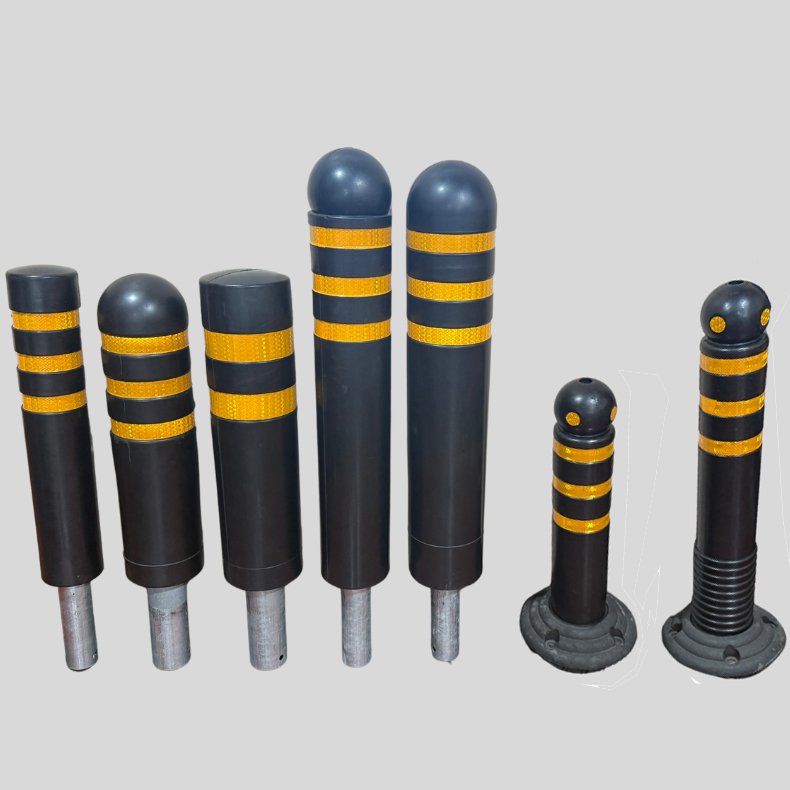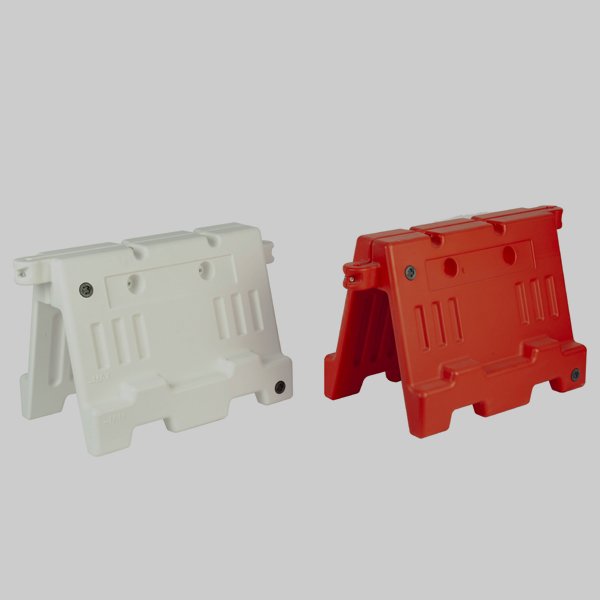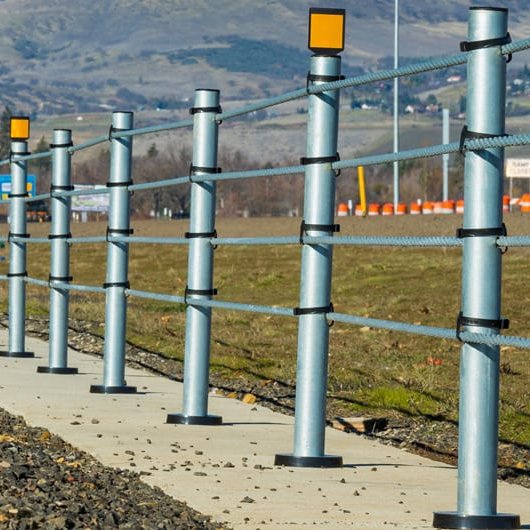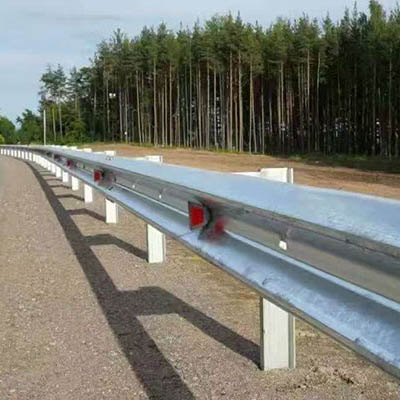When you pass by a road construction site, do you notice bright orange or yellow barricades? Those are actually traffic barriers that keep workers and drivers safe. They are generally used in many locations, such as roads and event areas.
These barriers are significant for road safety. In this guide, we will explain traffic barriers, their types, uses, cost, and official standards that you should follow.
What Are Traffic Barriers?
As you know, a barrier means something that blocks or stops. In the same way, a traffic barrier is also a tool that stops vehicles from going into dangerous areas. These are placed on roads for the security of drivers and pedestrians. Traffic barriers are not only for blocking the road, they also provide guidelines and directions.
9 Types of Traffic Barriers
Traffic barriers come in several types on the market. They are all designed for various purposes.
Bollards
Bollards are short and sturdy poles of 3 meters height. Which are Installed for permanent and long term usage. Generally, they are used to protect buildings and sidewalks. Steel or cast iron is mostly used in its manufacturing.

Water-Filled/Sand Barriers
Water filled and sand filled barrier is a plastic bag or can which is filled with sand or water. Actually, these barricades are mostly self-prepared and easy to move. We can call them urgent saviours. They are used to control traffic in emergency situations.

Cable Barriers
Cable barriers are made up of 2 to 3 wire ropes. You can stretch them between strong vertical posts. These cables are tightly secured to catch a vehicle if it goes off track. Actually, when a car hits them, the ropes absorb the pressure and slow down the vehicle. This thing helps to prevent major accidents.

Guardrail Barriers
These barriers are commonly placed at the edge of the road. Specifically, on the curves, slopes, ditches and bridges where there is a high risk of accidents. If a car hits a guardrail, it will absorb the impact and will spread out the force.

Jersey Barriers
Polypropylene or molded plastic is used in its manufacturing. Jersey barriers are placed at areas with lower speed vehicles. These barricades are not suitable for highway roads and motorways. Because they are best for traffic at a maximum speed of 70 km per hour.

Steel Barriers
Steel barriers are becoming popular these days because of their strength. Their main job is to stop cars from going off the road which can cause a crash. If we talk about specifications, they are 6m long units with TL-4 Mash Rating. Moreover, they are easy to install due to the T shaped connecting pins structure.

Crash Cushions
Crash cushions are specifically designed to protect people in case of accidents. You can place these barriers in front of bridge supports and toll booths. If a car gets crashed into it, the cushion will absorb the force.

Decorative Barriers
Decorative barriers are made to look good with safety features. They are often installed in cities to make streets safer as well as attractive. These barriers are available in different colors, sizes, materials and shapes.

Concrete Barriers
Concrete barriers are usually made up of reinforced concrete. Used to separate lanes of traffic and block the access of vehicles permanently. Actually, these barriers can also absorb the impact of vehicle strikes. That’s why these are used at highways and motorways.

Materials Used in Traffic Barriers
To fulfill the basic needs of road safety measures, barriers are manufactured with different types of material. Now, below we will talk about concrete, steel and plastic.
Concrete
Basically, concrete is used in the manufacturing of permanent barricades. Because concrete is a strong, durable and heavy material. Concrete rallings absorb the strike pressure and save the vehicle from falling down.
Steel
Steel is also a popular material preferred for production of traffic barriers. Steel barriers are strong as well as flexible. Their special “W” shaped design makes them more appealing. Because this structure allows a slight curve during an accident to spread force.
Plastic
Temporary barriers use plastic to provide lightweight and durable options. Due to their compact nature, the process of installation becomes easy. Plastic barricades are not suitable for permanent placement.
Common Applications of Traffic Barriers
Traffic barriers have a wide range of uses and are necessary for public safety. Very beneficial for managing traffic on roads and organizing large events.
-
Highways and Roads
Traffic barriers are mainly used on highways and roads. Basically, these tools represent separate traffic lanes. In case of permanent usage, steel and concrete barricades are suggested.
-
Construction Sites
If there is some construction happening on the road, then you can take the help of plastic and water/sand filled barricades for temporary blockage. When construction is completed, these barriers are removed.
-
School Zones
Decorative and bollard type of barriers are preferred in educational sectors. These barricades are also placed for temporary usage at the time of entry and exit of students to control rush.
-
Event Areas
During an event temporary barriers are used to guide the people. In case of heavy rush, you can install steel barricades at places with high risk of accidents. On the other hand, at some places decorative barricades are also used.
-
Parking Lots
In parking lots it’s very necessary to organize the traffic. So, if you want to fulfill this basic need, you should go for pointed temporary and permanent barricades.
Advantages of Traffic Barriers
As you know, traffic barriers play a vital role in road safety. They offer many benefits that protect both drivers and pedestrians in different situations.
Accident Prevention
Traffic barriers are specifically designed to reduce the risk of accidents. As they help to keep the vehicle on the road. Moreover, the barriers warn the drivers in case of damaged or under construction roads.
Crowd Management
During events and festivals the management of crowds is the most hectic process. To handle the flood of fans, you can place barricades at different places like parking, entry and exit.
Clear Lane Separation
They clearly divide traffic lanes and stop vehicles from drifting into the wrong side. Like on a highway, where barriers prevent head-on collisions and keep cars in their own lane.
Controlled Traffic Flow
In busy and narrow streets, traffic is managed by using metal or steel barricades. These barricades are preferred due to long lasting material used in manufacturing.
Disaster Impact Reduction
In case of emergency and natural disaster, these devices restrict special zones. In addition, it also helps out the public and workers in rescue operations.
Traffic Barrier Colors and Their Meanings
You can actually choose different colors for railings and barriers. Each color has its own meaning and delivers special messages to drivers.
-
- Red: For representing danger and hazardous zones
- Yellow: For telling about the construction area and public events
- Orange-White: To dominate caution markings
- Red-White: For the prevention of fireworks and equipment protection
- Black-White: To mark the pedestrian path and to separate specific zones
- Magenta-Yellow: To restrict the zone with harmful radiation
- Green-White: For representing safety and first aid
- Blue-White: To convey that the machinery is damaged
- Black-Yellow: Presents a physically damaged area
Cost of Traffic Barriers
Well, the price of traffic barriers generally depends on their brand and type. Plus, factors like material, weight and size also affect the cost of your traffic barriers. For example: lighter plastic barriers are an affordable option for you. On the other hand, if you want to buy steel/concrete barriers, they have a higher price.
If we talk about the wholesale price of traffic barriers, it’s between $15 to $60 in China. However, if you need branded and affordable products, JACKWIN offers you a range of options. You can also contact us for a quote according to your specific project and budget.
Regulations and Standards For Traffic Barriers
Compliance requirements for traffic barriers are made by organizations such as Federal Highway Administration (FHWA) in US, CEN in Europe and other national road safety authorities.
You should follow these rules for the safety of you and your driver/workers.
- You have to place traffic barriers around areas where workers and forklifts might meet. In this way, you can avoid accidents and separate the road traffic from foot traffic.
- EN 1317 standard regulates that the traffic barriers that you are going to place should be tested and of certified brands as well.
- You must always consider the ANSI MHI31.2-2021 standard when you want to purchase traffic barriers for your business. It will guide you all about which quality and deflection level you need in your traffic barriers.
According to the OSHA organization:
- Placements of traffic barriers should be in a way that it should have enough size and wide to cover the length of need (LON).
- 29 CFR Part 1926 Subpart G says that traffic barriers should be installed at work sites and on highways. So that you can control the traffic flow, and your workers feel safe around these areas.
Conclusion
In conclusion we can say, traffic barriers play an important role in road safety. Moreover, it controls vehicle flow and prevents accidents. It doesn’t matter which type of material is used, each type serves a specific purpose. On highways and parking lots, you can easily ensure protection and peace of mind.


-80x69.png)

